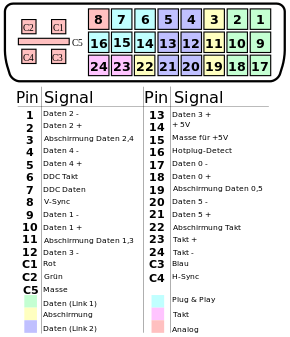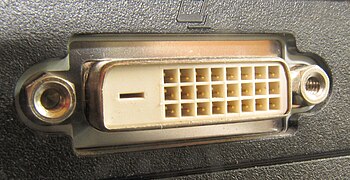Digital visual interface
Digital Visual Interface ( DVI ) [ ˈdɪdʒɪtəl ˈvɪʒuəl ˈɪntəfeɪs ] is an electronic interface developed by the Digital Display Working Group (DDWG) for the transmission of moving images. In the computer field , DVI was the first common standard for connecting monitors to the graphics card of a computer in order to transmit images digitally. However, one type of DVI, DVI-I, can also transmit analog images, so it has long been used as a universal interface for outputting analog and digital video signals.
DVI-D and DVI-I are electrically compatible with HDMI 1.0. With simple, passive adapters, DVI-D can be connected to HDMI interfaces.
Mini-DVI and Micro-DVI are mechanically different versions that are used in the Apple MacBook .
Signal transmission
DVI uses the TMDS standard for digital data transmission . The usual eight data bits of an RGB signal are transmitted serially - if necessary by means of a serializer that is connected using a double data rate function. When a connection is established, it is negotiated whether a single-link connection (max. 3.72 Gbit / s over 3 wire pairs) or a dual-link connection (max. 7.44 Gbit / s over six wire pairs) is used. Resolution, bit depth, frame rate and encryption are also agreed. Pixel frequencies above 165 MHz or bit depths of more than 8 bits (per pixel and color) always require a dual-link connection.
The agreement is made when the monitor notifies the manufacturer, model, serial number and color calibration data of its supported video modes via DDC to the computer. If the computer sends a different video format than the one supported by the monitor, there is often no picture.
The digital data transmission usually results in quality advantages compared to the (analog) connection with a VGA or SCART cable. The latter transmission method requires two signal conversions (unnecessary with digital screens): from digital to analog at the video output, and back from analog to digital in the monitor. Accordingly, runtimes have a strong effect on electronics.
The maximum cable length when connecting a DVI device (monitor) depends on the attenuation and crosstalk in the connection cable as well as the quality of the signal amplification. A length of 10 m should not be exceeded. If the cable is longer, a DVI amplifier must be used between two cable sections. With analog transmission, if the signal quality at the end of the cable is inadequate, the picture becomes blurred ; In the case of digital transmission, the processing of the incoming signal breaks down completely due to high bit error rates .
Since DVI is designed for both digital and analog transmission, blank pixels are always sent at the end of each transmitted line, which are actually obsolete with digital monitors. CRT displays need this to bridge the time in which the electron beam can move from the end of the line (or the last line) to the beginning of the next line (or the first line).
Pin assignment
Depending on the pin assignment of a DVI connection, this can
- only analog (DVI-A),
- digital only (DVI-D), or
- both analog and digital (DVI-I)
Output, transmit or display signals. In addition, the bandwidth can be doubled by using twice as many TMDS links (called dual links), which enables higher resolutions.
The elongated ground contact of a DVI-I connector (C5) is slightly wider than that of a DVI-D connector, so that a DVI-I connector cannot be plugged into a DVI-D socket, even after removing the four analog contacts. A DVI-D plug, on the other hand, can be connected to a DVI-I socket.
Not every graphics card or monitor uses all the transmission options of the DVI socket at its connection.
For example, a monitor can have a DVI-I socket, although only digital transmission is used, or a graphics card can have a dual-link socket, although no high resolutions are supported at all. The DVI-I dual link socket is then only used so that all connector types fit.
DVI-I (Integrated)
In connection with a DVI-I slot, DVI-I cables can transmit digital and analog signals and differ in the number of connected plug contacts. A simple DVI cable (single link, 3 TMDS links in total) has 18 + 5 contacts and is sufficient for WUXGA resolution of 1920 × 1200 at 60 Hz. Cables with 24 + 5 contacts have two TMDS links per color (dual -Link, a total of 6 TMDS links) for high-resolution screens, e.g. W QXGA , maximum 2560 × 1600 pixels at 60 Hz.
If a combined signal (DVI-I) is available at the DVI socket of the graphics card, an analog VGA monitor can also be operated at this socket with the aid of a purely passive adapter. Such a DVI-I-to-VGA adapter directly uses the analog and plug-and-play signals of the DVI interface and makes them available in accordance with the VGA standard. There are also cables that have VGA on one end and DVI on the other, technically doing the same thing but saving one connector.
With HDMI 2.0 graphics cards with a DVI connection, the same HDMI 2.0 signals are generally used. Therefore, 4K televisions can also be controlled via the DVI-I connector with a resolution of 3840 × 2160.
DVI-D (digital)
DVI-D cables can only transmit digital signals and differ in the number of connected plug contacts. DVI-D cables (single link) have 18 + 1 (in rare cases 17 + 1) contacts and are sufficient for WUXGA resolution of 1920 × 1200 at 60 Hz.
DVI-D cables (dual link) have 24 + 1 pins with a second TMDS connection for a maximum of 2560 × 1600 60 Hz or 1920 × 1080 144 Hz (or 23 + 1 pins, because most of them are commercially available Cables, pin 8 is not connected, even if they are offered as 24 + 1). There are also DVI-D cables on the market with only 12 + 1 pins, no DDC data is transmitted here, so that the operating system can no longer automatically recognize the screen.
DVI-A (analog)
DVI-A cables can only carry analog signals. A DVI-A connector has 12 + 5 contacts. In practice, DVI-A is only used as an adapter cable to VGA. DVI-A cables can also be used in DVI-I connections, as these also enable analog data transmission.
A passive VGA-to-DVI-A adapter transmits the analog signals from the graphics card to the monitor via the DVI cable. This must have a DVI-A input so that it can display the signals. The passive adapter can not therefore carry out any analog-to-digital conversion of the analog VGA signal; an improvement in the quality of the (poorer) analog signal by "rerouting" it to the (per se better) digital DVI cable is not achieved.
DVI connector
history
The Digital Display Working Group (DDWG) was an amalgamation of Intel , Silicon Image , Compaq , Fujitsu , Hewlett-Packard , IBM and NEC Corporation with the aim of developing a digital interface for connecting digital displays to PCs.
After the adoption of version 1.0 of the DVI specification in 1999, the DDWG dissolved again a short time later.
future
In the entertainment electronics sector, the industry primarily relies on HDMI .
Some manufacturers of DVB receivers (e.g. Dream Multimedia ) and graphics cards ( AMD Radeon HD ) transmit digital audio data as well as high-resolution digital video data via the DVI socket. These signals are then compatible with HDMI.
DVI-D and DVI-I are upwardly compatible with HDMI, which means that all DVI-D signals can be converted to HDMI. Conversely, however, not all HDMI signals can be converted to DVI-D. For example, copy protection such as HDCP is only optional with DVI-D.
In the computer sector, the DisplayPort has replaced the VGA and all variants of the DVI connections from around 2016 and, thanks to the significantly increased bandwidth, enables higher resolutions (4K, 5K) with a greater color depth in a more compact form.
See also
- DMS-59 - a connector for connecting two screens
- High Definition Multimedia Interface (HDMI)
- Serial Digital Interface (SDI)
- Unified Display Interface (UDI)
- DisplayPort
- VGA connector
Web links
- Digital Display Working Group - standardization organization for DVI. Archived from the original on February 24, 2011 ; accessed on March 13, 2014 .
- Mark Allen: DVI compatibility for sticklers. 2007, accessed November 9, 2019 .
Individual evidence
- ↑ ATI Radeon HD 2900 XT: Graphics card and special features , Review Hartware.net, May 14, 2007
- ↑ Radeon HD 2400 XT and 2600 XT review , The Guru of 3D, June 27, 2007
- ↑ Christof Windeck: VGA socket doomed to extinction. In: heise online. Heise Zeitschriften Verlag, December 10, 2010, accessed on February 13, 2015 .







